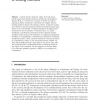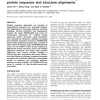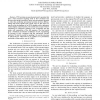4762 search results - page 13 / 953 » About the use of protein models |
BMCBI
2008
13 years 9 months ago
2008
Background: Prediction of disulfide bridges from protein sequences is useful for characterizing structural and functional properties of proteins. Several methods based on differen...
ALIFE
2006
13 years 9 months ago
2006
Current theories about the origin of the eukaryotic cell all assume that during evolution a prokaryotic cell acquired a nucleus. Here, it is shown that a scenario in which the nucl...
GCB
2005
Springer
14 years 3 months ago
2005
Springer
Motivation: With the increasing availability of protein structures, the generation of biologically meaningful 3D patterns from the simultaneous alignment of several protein struct...
NAR
2008
13 years 9 months ago
2008
Multiple sequence alignments are essential in computational sequence and structural analysis, with applications in homology detection, structure modeling, function prediction and ...
CIBCB
2005
IEEE
14 years 3 months ago
2005
IEEE
— PTS1 proteins are peroxisomal matrix proteins that have a well conserved targeting motif at the C-terminal end. However, this motif is present in many non peroxisomal proteins ...



